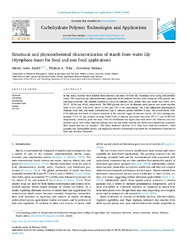| dc.identifier.citation | Abelti, A. L., Teka, T. A., & Bultosa, G. (2024). Structural and physicochemical characterization of starch from water lily (Nymphaea lotus) for food and non-food applications. Carbohydrate Polymer Technologies and Applications, 100458 | en_US |
| dc.description.abstract | In this study, starches were isolated from rhizomes and seeds of water lily (Nymphaea lotus) using cold distilled water. The structural and physicochemical properties of the isolated starches were compared with potato, rice, and maize starches. The amylose content (g/100 g) of rhizome, seed, potato, rice, and maize was 23.03, 24.5. 25.17, 21.26, and 19.83, respectively. The SEM granule size (µm) of rhizome, seed, potato, and maize starches were 11.19±3.69, 3.56±0.92, 30.63±11.09, and 7.97±1.48, respectively. The X-ray diffraction polymorph of rhizome, seed, rice, and maize demonstrated type A, whereas potato exhibited B-type. The deconvoluted ATR-FTIR indicates low level of ordered structure in the external region of rhizome starch. The RVA pasting temperature (71.9 °C) and setback viscosity (1292.5 cP) of rhizome was lower than seed (78.3 °C and 3228.5 cP, respectively). However, peak viscosity (7201 cP) of rhizome was higher than seed (4105 cP). Rhizome and seed starches can be used where high viscosifying than rice and maize starches and better shear breakdown resistance than potato starches are required. This study indicated starches of N. lotus have medium amylose%, small granular size, hydrophillic nature, and high peak viscosity of potential to promote for development of products in food and non-food industries. | en_US |

